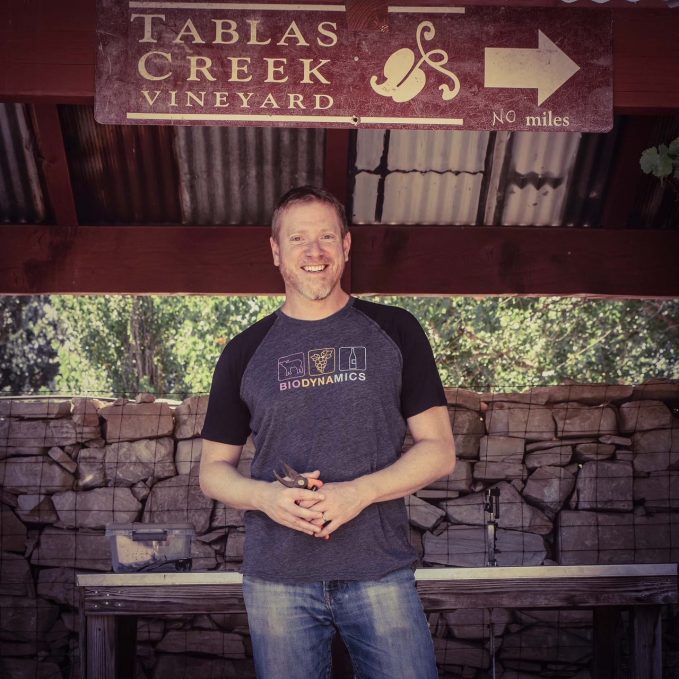Darin Szilagyi
Wine X Online Edition
Sleepers. Love ‘em.
Sometimes it’s the brands that are right in front of you and perhaps on your “list,” but you haven’t found the reason to 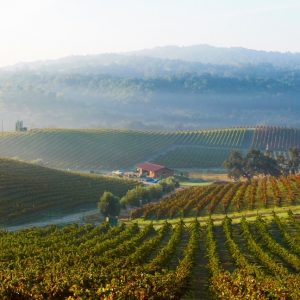 buy yet…… Guilty. Curiously guilty. OK, guilty with a smile because I knew I found a keeper when I finally went for these bottles. Total keeper. Let’s talk…..
buy yet…… Guilty. Curiously guilty. OK, guilty with a smile because I knew I found a keeper when I finally went for these bottles. Total keeper. Let’s talk…..
Just being honest, I’m taking a little creative license with calling Tabals Creek a “sleeper” because it’s earned a reputation as a catalyst for all of the passionate rhone-varietal lovers here in the US. They’ve been an excellent label for a long time, and their fans are loyal. Really loyal. Tablas Creek also has a remarkable story I’ve somehow skipped past, and now I wish I hadn’t.
More than a handful of premium wines in Napa tie back to France’s noble chateau. Their heritage and parentage become a massive part of their draw and mystique. No judgment zone. I happen to enjoy everything about those wines and the experiences I’ve had in their Domaine.
Continuing with the non-judgment zone theme, I’m going to guess that maybe five percent of our readers know that Tablas Creek also claims noble lineage. It does. And their story will pull you in like a magnet.
Tablas Creek is the child of Robert Haas, a successful American wine merchant, and Jacques and Jean-Paul Perrin, the proprietor-family that stewards Chateau Beaucastel, among the noblest Rhone producers. In fact, for many years, Robert Haas marketed the Perrin family wines throughout the US. In time, as the relationship grew, it moved from cases sold to imagining “What if?” What if California could make an amazing Rhone wine?
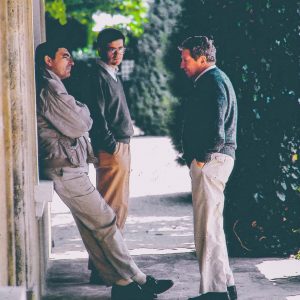 In 1989 the Haas Family and the Perrin family decided to stop imagining and start the process of building a Rhone-blend-dominant brand in California, combining the boundless experimentation that has made California wine so incredible with Beaucastel’s 500 years of passionate commitment to varietals like Syrah, Grenache, Roussane, Mourvedre, Marsanne, and many others. The perfect location: Paso Robles. Bring it all together, and fast-forwarding thirty years, it turns out that Tablas Creek has played an essential role in two movements: The widespread Rhone obsession and the emergence of Paso as a premium wine region.
In 1989 the Haas Family and the Perrin family decided to stop imagining and start the process of building a Rhone-blend-dominant brand in California, combining the boundless experimentation that has made California wine so incredible with Beaucastel’s 500 years of passionate commitment to varietals like Syrah, Grenache, Roussane, Mourvedre, Marsanne, and many others. The perfect location: Paso Robles. Bring it all together, and fast-forwarding thirty years, it turns out that Tablas Creek has played an essential role in two movements: The widespread Rhone obsession and the emergence of Paso as a premium wine region.
We caught up with Jason Haas a few months ago and are excited to tell the Tablas Creek story. So grab a glass, close your eyes, and imagine you are one table over at Les Petit Canales in Paso, listening to our chat.
Wine X: Sooner or later, I’m going to ask you to tell me how it all started, so why not now?
Jason Haas: “(laughing) Sure. We had the idea of what we wanted to make before we knew where we would make it. That’s pretty contrary to most of the stories I’m sure you hear. I’ll guess that you talk to people who are dedicated to Napa or Sonoma, and the land drove the varietal selection and such. Well, we flipped that logic. My father’s business deeply connected him and my family to the Perrin family of France. Dad had a longstanding friendship with Francois and Jean-Paul Perrin. The Perrin family, of course, has owned Chateau Beaucastel since the very early 1900s. Chateau Beaucastel itself dates back to the 1500s. Beautiful wines, beautiful family, and beautiful history. My father loved Chateauneuf du Pape. So a conversation turned into a business, which turned into a commitment to do Rhone varietals SOMEWHERE in California. We were confident that, with enough determination, we could find the perfect spot to make great, exciting Rhone-style wines.
Wine X: So Paso….. I want to hear how you landed on Paso because, just thinking about the timing, you guys were pretty early in the Paso movement, right?
Haas: Grammy “Yeah. Exactly. So in 1985, our families put together the partnership and went about the process of looking for the right property. I guess you could say we stumbled on Paso, but the fact that dad and the Perrins were looking there proves how intensely they searched for precisely the right place. Because I can assure you that they went everywhere. The way the story has been told to me is that they were looking for some sort of success clue. At the time, no California region was known for great Rhone varietals. So it’s not like we could follow someone else’s trial and error. I’m told that the clue they settled on was to look hard at regions making spectacular Zins. The thinking was that, since Zin is from Croatia, which has a Mediterranean climate quite similar to the Southern Rhone, that good Zin would be a marker of sorts.
Wine X: I’m imaging three guys driving back roads like a scene from a Hunter S. Thompson novel
Haas: “Well, they did a lot of driving, yes. And actually, that’s what led them to our property. It was a drive along the 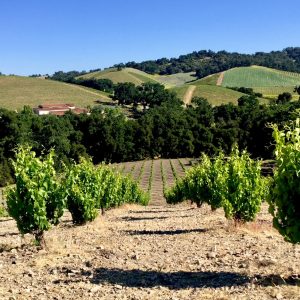 western edges of Paso Robles, scanning and taking everything in. I’m not sure who was the first to see it, but someone noticed a rough road cut with a beautiful chalky old seabed…….. Everywhere…. .It was the first time they had seen those soils, which of course, is a big part of the terroir of the Southern Rhone. So you can imagine the “lightning in a bottle” moment. And, so in 1989, the partnership acquired the 128 acres here in Paso, right there at that road cut they drove by, and that’s where Tablas Creek has made its home ever since.”
western edges of Paso Robles, scanning and taking everything in. I’m not sure who was the first to see it, but someone noticed a rough road cut with a beautiful chalky old seabed…….. Everywhere…. .It was the first time they had seen those soils, which of course, is a big part of the terroir of the Southern Rhone. So you can imagine the “lightning in a bottle” moment. And, so in 1989, the partnership acquired the 128 acres here in Paso, right there at that road cut they drove by, and that’s where Tablas Creek has made its home ever since.”
Wine X: “So by 1989, you had the vision, the inspiration, and 128 acres of chalky prehistoric seabed…..”
Haas: “ Pretty much (laughing). But you’re hitting on a good point which is the obvious ah-ha…. There really weren’t many Rhone varietals in the state to use for plantings. It’s not like we could call UC Davis or a specialty nursery and order up 50 acres of Grenache or Mouvedre. So getting the right grapes here wasn’t a trivial matter at all.”
Wine X: “Which probably leads you back to Beaucastel?”
Haas: “Exactly….. We took cuttings from Chateau Beaucastel. Marsanne, Rousanne, Mouvedre, Syrah, Grenache, Picardan, Picopul, Counoise, Grenache Blanc, Clairette Blanc…… etc., and then we went through the process of getting them cleared through UC Davis…. Some were cleared pretty quickly, but the last few stragglers are just now coming to us and ready to plant. Fortunately, the Grenache cleared early, or else we’d probably not be talking. (laughs)
Wine X: “Looking back, was Paso the right choice?”
Haas:: “No doubt this area is well suited to do Rhone-style wines of outstanding character. Paso can produce a lot of 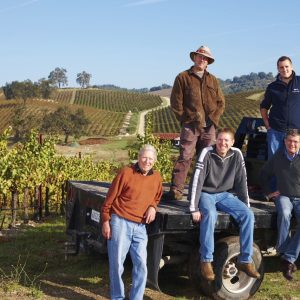 other varietals as well, but you can see by the growth of Rhone-varietal producers that have made the central cost their home. This place is special. Our nights are cold, which is perfect during the growing season. The days are hot. That’s what people think of if they’ve been to Paso Robles before. But it’s hot during the summer days and warm in the shoulder seasons. But at night, it gets cool enough to give the maturing grapes time to rest and reset. That means we can pick with the right sugars because the weather provides us really long growing seasons… cold nights help the growing season… we actually pick a week or two after Beaucastel. The cold nights allow us to maintain acids on everything, which is obviously awesome for our white wines… the acids are so essential there, and we’ve got them.
other varietals as well, but you can see by the growth of Rhone-varietal producers that have made the central cost their home. This place is special. Our nights are cold, which is perfect during the growing season. The days are hot. That’s what people think of if they’ve been to Paso Robles before. But it’s hot during the summer days and warm in the shoulder seasons. But at night, it gets cool enough to give the maturing grapes time to rest and reset. That means we can pick with the right sugars because the weather provides us really long growing seasons… cold nights help the growing season… we actually pick a week or two after Beaucastel. The cold nights allow us to maintain acids on everything, which is obviously awesome for our white wines… the acids are so essential there, and we’ve got them.
Wine X: “Paso is definitely known for being hot, but it’s also known for being dry. Right? ”
Haas:: “Definitely. And everyone here works together to make that work. Paso’s rainfall is not bad in aggregate, but in some years, a lot of the rain comes in one or two bursts. We have it a little easier at Tablas since we’re up in the hills and close to the ocean. It’s a more maritime microclimate, which generates more rain. We usually get around 26 inches a year.
Wine X: “You mentioned that the Paso Robles winemaking community works together. That’s the other thing that comes to mind for me as an outsider. At least that’s my perception.”
Haas:: “ No doubt. And the growth of the wine industry here is feeding a lot of positive energy and collaboration among everyone here. When we started, there were seventeen wineries in the Paso area, and now there are three-hundred-ish? It’s also become a famously experimental place. And everyone coexists and is curious about the successes each other is having. We still have those that are keeping up the traditions of old-school zins, and of course, the cab producers, and then there’s a lot of people doing cool non-traditional experimental wines. We’re a community that celebrates and welcomes winemaking curiosity. There’s no scorn for people who have an idea. You never hear someone say, “hey, you shouldn’t be doing that in Paso.”
Wine X: “I see that everywhere. Whenever I talk with a Paso winery, I hear equal parts of ‘here’s my story and ‘here’s why we love Paso.’”
Haas:: “Truth! And that’s gone back a generation. For the last forty years, everyone in the wine business here has done a lot of work together. For example, we were convinced as a community to take action on our own to define the 11 sub-AVAs together rather than having individuals carve them out one at a time. So sixty or so people put up the money to do it right. We had UC Davis come down to “get the lines in the right place and let science tell us.” That only happens when you have a spirit of cooperation. The founders, like Gary Eberle and Justin Baldwin, those guys always talked about Paso first….and their brands second. Then when there were enough producers, the Paso Wine Alliance got up and going. They all did amazing work. So our generation, well, we have a long shadow to live up to, and we’re very thoughtful on how we continue to extend the founder’s hard work,”
Wine X: “The last three wine dinners I’ve been to have had pretty strong undertones of Paso GSM love. It’s not a new thing, obviously, but interestingly, wine drinkers discover CDP and Rhone styles at a certain point in their journey…… You guys have been in the game since the beginning, though, and you’re unique. A vanguard.”
Haas:: “ Yeah, we started before there was really much demand, but that didn’t matter. Tablas was always going to be Rhone varietals. It hasn’t always been easy. In the early stages, we made only two wines, and both were blends. Think about it: a blend wine coming out right when varietal wines were really taking off. And even more challenging, our blends were from grapes that no one heard of from a region no one heard of. That made it hard to get people to sell them or add them to a wine list, even though they really liked what they were sampling. We realized early that we needed to be much more proactive in creating an audience on our own and telling our story. Twenty years ago, most people could name no more than six wine grapes, And none were ours. Well, maybe Syrah. But that’s it. So we decided to emphasize every educational opportunity we could find. And, of course, we coordinated with everyone else, like Hospice du Rhône and The Rhône Rangers.
Wine X: Fast forward to today. Has the approach changed?
Haas:: In the beginning, we did a lot of in-person education, like varietal blendings, to show the elements that go into our wines. But now, with social media, you can build a message and a story so much quicker… the Tablas Creek blog has been a great tool….. but we haven’t been doing it alone… being engaged with others has been one of the most fun and rewarding things.
Wine X: What differences do you see here in Paso compared to what’s worked at Beaucastel?
Haas:: “Oh, there have been a few…. Whites have been far bigger here…. I believe whites are only 8% of Beaucastel… but for us, the first few vintages of whites were so compelling we knew we had something special. We’ve become around 35% white, 15% rose, and 50% red. That’s a very different mix than what we originally anticipated. Another surprise came from the varietals usually associated with the Northern Rhone. The early ripening grapes like Syrah and Viognier had done fantastically here. And the super-trace varieties, like Picpoul, Counoise, and Picardan, have been surprisingly impressive. That has given us a chance to bottle some of these on their own. We have people who love it so much and buy it up so quickly that we struggle to hold back even a few bottles for experimentation.
Wine X: And you’re all-in on organic vineyards, right?
Haas:: “ Yeah. All-in. We started farming organically because that’s what worked at Beaucastel. The Perrin’s felt that approach provided the best possible expression of terroir. And over time, we went biodynamic and now regenerative. We’ve even brought in our own flock of sheep to graze the vineyards, flowering plants, keeping our own bees, fruit trees, and whatnot. ”
Wine X: “ Can you tell if it’s translating into the wines?”
Haas:: “Oh, unquestionably. It’s making an unbelievable difference. Paso is really stressful on grapes. Think about it. 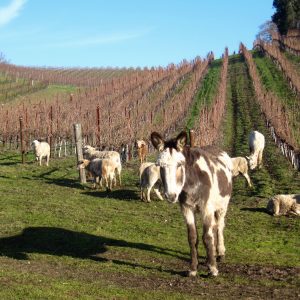 The temperature swings, going from drought to deluge in the rain, etc. So we started thinking, “what can we do to give our vines an easier life.” Our first thought was to make our soils as friendly as possible, and we started that experience on 20 acres. We assumed that the payback on our effort might be noticeable down the road and might simply be longer-lived vines. But to our surprise, we saw a noticeable difference during the blind testings of the very first vintage. All of the organic wines floated to the top. And the following year, it happened again. So we doubled our block commitment…. And it happened again. That was it. All the proof we needed. We didn’t need to know why or which of the things we were doing impacted the wine, but we knew that we wouldn’t be doing the right thing for our wines if we didn’t go all in. So since 2016, we’ve been on the best run Tablas Creek has ever seen, despite very different vintages.”
The temperature swings, going from drought to deluge in the rain, etc. So we started thinking, “what can we do to give our vines an easier life.” Our first thought was to make our soils as friendly as possible, and we started that experience on 20 acres. We assumed that the payback on our effort might be noticeable down the road and might simply be longer-lived vines. But to our surprise, we saw a noticeable difference during the blind testings of the very first vintage. All of the organic wines floated to the top. And the following year, it happened again. So we doubled our block commitment…. And it happened again. That was it. All the proof we needed. We didn’t need to know why or which of the things we were doing impacted the wine, but we knew that we wouldn’t be doing the right thing for our wines if we didn’t go all in. So since 2016, we’ve been on the best run Tablas Creek has ever seen, despite very different vintages.”
Wine X: “Personal question: Did you always plan to be in the family business? Did you go to Cornell? Checking my map, but not finding it in Cali….”
Haas:: “ That’s an easy yes. We are wine people…. I always figured this was where I would land. But I also knew I 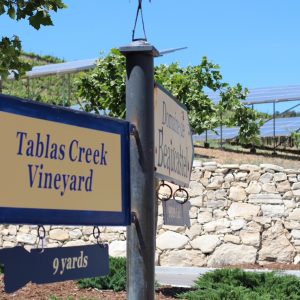 didn’t want to go straight into a family business out of school. So I got an MS in Archeology and taught for a few years until I was recruited into the tech bubble doing UX stuff. That whole experience gave me an intense business education. In 2001, I left, which was a good time to come home because it was around that time that Tablas Creek grew from a project to a business. And honestly, it was a struggling business. We overestimated the value of good wine, the connection of Beaucastel, and the market acceptance of Rhone-style wines. Dad asked me to tackle the business challenge of educating the market and building momentum to make the business work. Honestly, I didn’t realize the dire situation until I got here and saw the numbers. The year I arrived, we sold 4,000 cases while making 12,000 cases….. that doesn’t take a lot of common sense to figure out we had a problem. It took a lot of conviction, but in the end, the events, the trade interviews, the festivals, the tasting room conversations, and the personal conversations paid off. But most of all, we figured out that the path to success was the tasting room and the experience associated with it… it magnified all of the other things downstream. By 2009 we had sales requests for 20,000 cases, and we were making 12,000, which is a different problem, but a good problem.”
didn’t want to go straight into a family business out of school. So I got an MS in Archeology and taught for a few years until I was recruited into the tech bubble doing UX stuff. That whole experience gave me an intense business education. In 2001, I left, which was a good time to come home because it was around that time that Tablas Creek grew from a project to a business. And honestly, it was a struggling business. We overestimated the value of good wine, the connection of Beaucastel, and the market acceptance of Rhone-style wines. Dad asked me to tackle the business challenge of educating the market and building momentum to make the business work. Honestly, I didn’t realize the dire situation until I got here and saw the numbers. The year I arrived, we sold 4,000 cases while making 12,000 cases….. that doesn’t take a lot of common sense to figure out we had a problem. It took a lot of conviction, but in the end, the events, the trade interviews, the festivals, the tasting room conversations, and the personal conversations paid off. But most of all, we figured out that the path to success was the tasting room and the experience associated with it… it magnified all of the other things downstream. By 2009 we had sales requests for 20,000 cases, and we were making 12,000, which is a different problem, but a good problem.”
Wine X: “ A really good problem. Cheers to that. So, the last question…… Imagine if you weren’t making Rhones…… what would you be making? Any secret curiosities?
Haas:: “Honestly, I don’t know that I could answer. I’ve always thought that ‘Where you are tells you what you should be’…and in our case, once we found this site, we were locked in. This property is amazing, and it’s perfect for our varietals. I truly believe that even if we hadn’t started with Rhones, we would have found our way here anyway. I guess, if 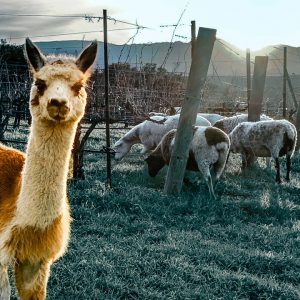 I really thought about it, I could make something else in Paso… something Italian or Spanish.. there’s a ton of potential for Italian wines, but I don’t think it will be me because I have so much more I want to do with Rhône’s here. Our story is just starting. For example, in the last couple of years, we’ve finally got the last of the Beaucastel varietals here. That’s a significant milestone for my family because Dad was determined to get all the grapes here, not just a few varietals. For some varietals, it’s taken 15 years at UC Davis to clean up the vines and release them to us. But this past year, we finally got the last one cleared. I’m so excited to have all of the 14 grapes available to us to do our Esprit bottlings. And, of course, our nursery is helping to get others into the game too. Along the way, we’re preserving history. For example, Picardan nearly suffered an extinction event due to powdery mildew and phylloxera in France. We’re working to bring it back.… that kind of history, plus all of our experiential work, makes Tablas a privilege to be involved with. It motivates me every day.
I really thought about it, I could make something else in Paso… something Italian or Spanish.. there’s a ton of potential for Italian wines, but I don’t think it will be me because I have so much more I want to do with Rhône’s here. Our story is just starting. For example, in the last couple of years, we’ve finally got the last of the Beaucastel varietals here. That’s a significant milestone for my family because Dad was determined to get all the grapes here, not just a few varietals. For some varietals, it’s taken 15 years at UC Davis to clean up the vines and release them to us. But this past year, we finally got the last one cleared. I’m so excited to have all of the 14 grapes available to us to do our Esprit bottlings. And, of course, our nursery is helping to get others into the game too. Along the way, we’re preserving history. For example, Picardan nearly suffered an extinction event due to powdery mildew and phylloxera in France. We’re working to bring it back.… that kind of history, plus all of our experiential work, makes Tablas a privilege to be involved with. It motivates me every day.

